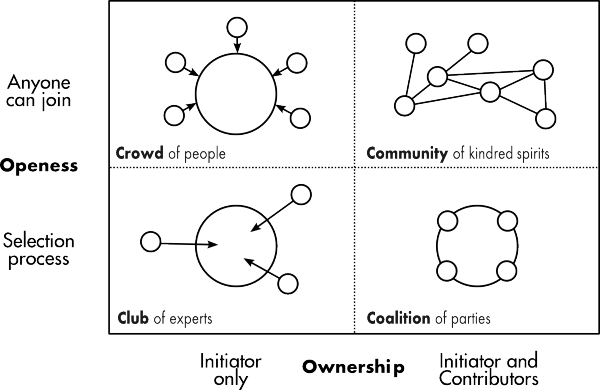Four Types of Co-Creation
Source: Five_Guiding_Principles of Co-Creation)
A Typology of Co-Creation

Club of experts.
The ‘‘Club of Experts” style of co-creation is best suitable for very specific, time-pressured challenges that demand expertise and breakthrough ideas. Contributors meet certain specific participation criteria and are generally found through an active selection process. Quality of input and chemistry between participants are key to success. ‘No-box’ thinkers are the ones you want to have in any project.
Example: Nokia organises ‘lead user’ and ‘expert’ co-creation sessions to develop visionary new products and services. We at Fronteer Strategy are a partner of Nokia in these projects, where bold new steps have been designed.
Crowd of People
Also known as “Crowdsourcing”, this form is all about the Rule of Big Numbers: anyone can join. For any given challenge, there might be a person ‘out there’ with a brilliant idea that deserves considering. Using online platforms, people can rate and respond to each other’s suggestions. There is often a marketing and seeding component/objective attached to the process.
Crowdsourcing ‘unleashes the power of the masses’, but often takes longer - and you’re not sure that the best people will (want to) contribute.
Nokia: Frontrunner when it comes to using lead users, experts and beta testers
Example: Threadless is a successful online t-shirt platform where contributors can send in and rate t-shirt designs. Profits on sold items are shared with the designer in question. Not bad: a full 30% profit margin selling t-shirts with no R&D cost, low investments (no stock or debtors) and hardly any employees.
Coalition of Parties
In certain complex situations, a “Coalition” of parties team up to share ideas and investments (Co-branding is also an example of Coalition-style co-creation). Each of the parties brings a specific asset or skill to the party. Technical breakthroughs and the realisation of standards often happen only when multiple parties collaborate - especially important when capital expenditures are high. Key success factors include sharing knowledge and creating a common competitive advantage.
Example: Heineken has successfully launched a home draft system called the ‘Beertender’ in co-operation with Krups. A development period of 10 years resulted in the first true packaging innovation in beer in a long time. Also, Heineken has worked with outsiders to develop for example its aluminium bottle range.
Community of kindred spirits
The “Community” form is most relevant when developing something for the greater good. Groups of people with similar interests and goals can come together and create. This model - so far - works mostly in software development and leverages the potential force of a large group of people with complementary areas of expertise.
Example: The Linux open source operating system software was developed by users and for users. The software code is free to use and owned by nobody. It started with one simple e-mail with a request for help."